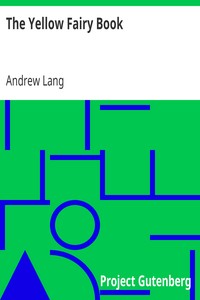| Author |
Lang, Andrew, 1844-1912 |
| Title |
The Yellow Fairy Book
|
| Note |
Reading ease score: 83.1 (6th grade). Easy to read.
|
| Contents |
The cat and the mouse in partnership -- The six swans -- The dragon of the North -- Story of the emperor's new clothes -- The golden crab -- The iron stove -- The dragon and his grandmother -- The donkey cabbage -- The little green frog -- The seven-headed serpent -- The grateful beasts -- The giants and the herd-boy -- The invisible prince -- The crow -- How six men travelled through the wide world -- The wizard king -- The nixy -- The glass mountain -- Alphege, or The green monkey -- Fairer-than-a-fairy -- The three brothers -- The boy and the wolves, or The broken promise -- The glass axe -- The dead wife -- In the land of souls -- The white duck -- The witch and her servants -- The magic ring -- The flower queen's daughter -- The flying ship -- The snow-daughter and the fire-son -- The story of King Frost -- The death of the sun-hero -- The witch -- The hazel-nut child -- The story of Big Klaus and Little Klaus -- Prince Ring -- The swineherd -- How to tell a true princess -- The blue mountains -- The tinder-box -- The witch in the stone boat -- Thumbelina -- The nightingale -- Hermod and Hadvor -- The steadfast tin-soldier -- Blockhead Hans -- A story about a darning-needle.
|
| Credits |
Produced by David Widger and Charles Keller for Tina
|
| Summary |
"The Yellow Fairy Book" by Andrew Lang is a collection of fairy tales edited for children, written during the late 19th century. This work compiles various enchanting stories from different cultures, all imbued with magical themes and moral lessons that are typical of fairy tales. The tales range from whimsical adventures to cautionary tales involving royalty, magical creatures, and the consequences of one’s actions. The beginning of the book introduces the collection with a dedication and a preface that addresses the whimsical nature of fairy tales and their importance in a child’s literary development. It outlines the diverse origins of the stories included, hinting at their cultural richness—from Russian and German folklore to tales by famous authors such as Hans Christian Andersen. The opening anecdotes, such as "The Cat and the Mouse in Partnership," showcase clever animals and the moral lessons learned from their interactions, setting the stage for a series of whimsical narratives filled with adventure and imagination that follow throughout the book. (This is an automatically generated summary.)
|
| Language |
English |
| LoC Class |
PZ: Language and Literatures: Juvenile belles lettres
|
| Subject |
Fairy tales
|
| Subject |
Folklore
|
| Category |
Text |
| EBook-No. |
640 |
| Release Date |
Aug 1, 1996 |
| Most Recently Updated |
May 29, 2019 |
| Copyright Status |
Public domain in the USA. |
| Downloads |
490 downloads in the last 30 days. |
|
Project Gutenberg eBooks are always free!
|

